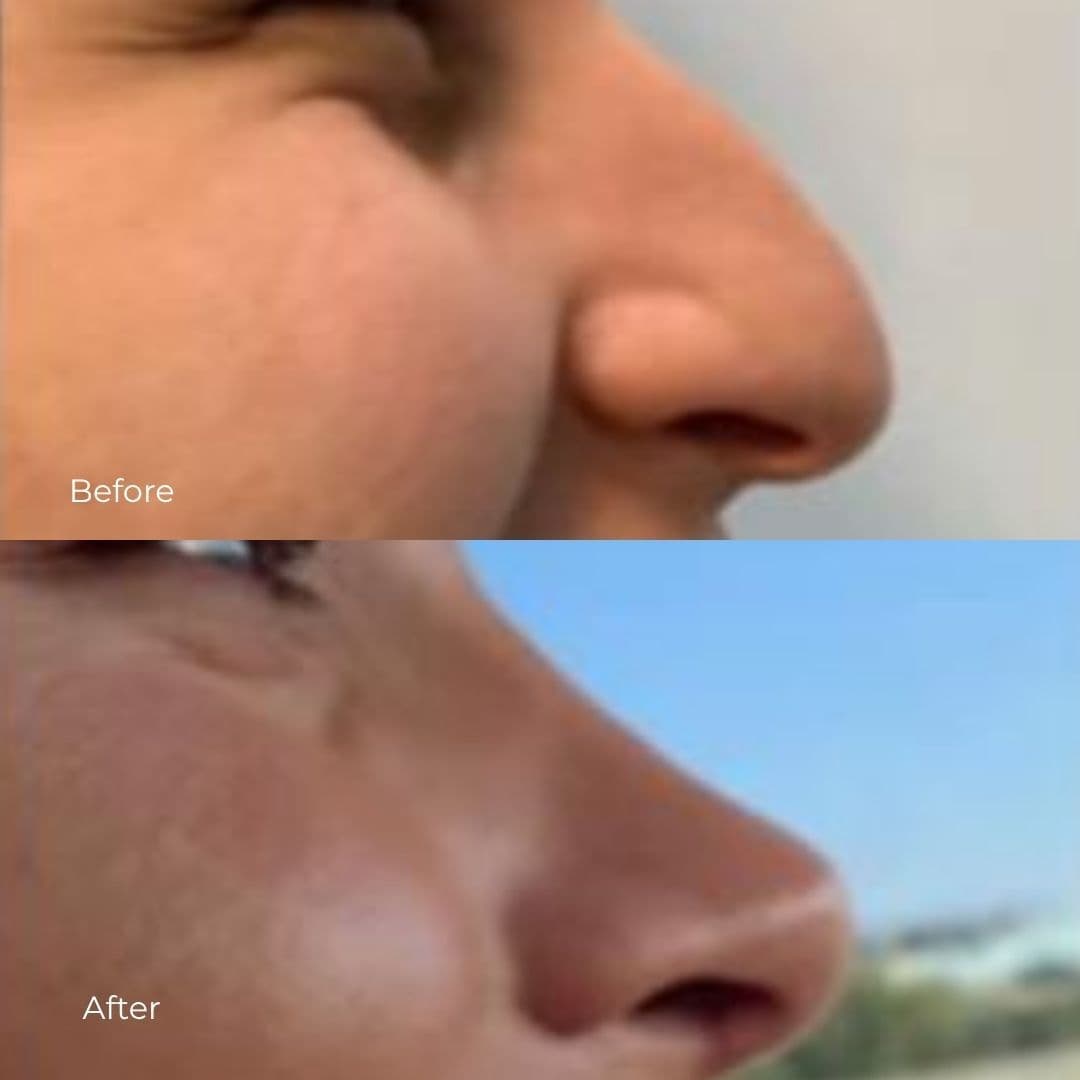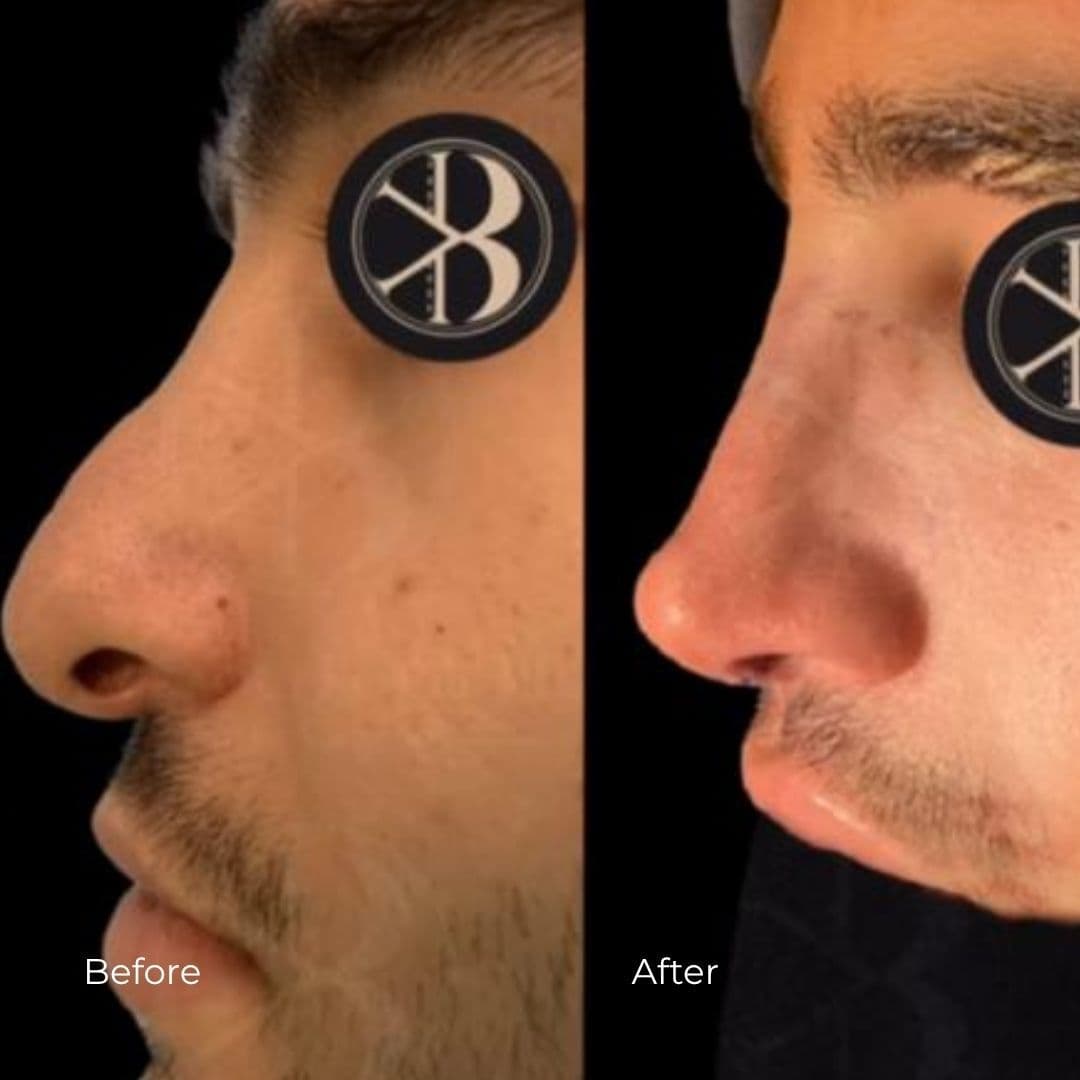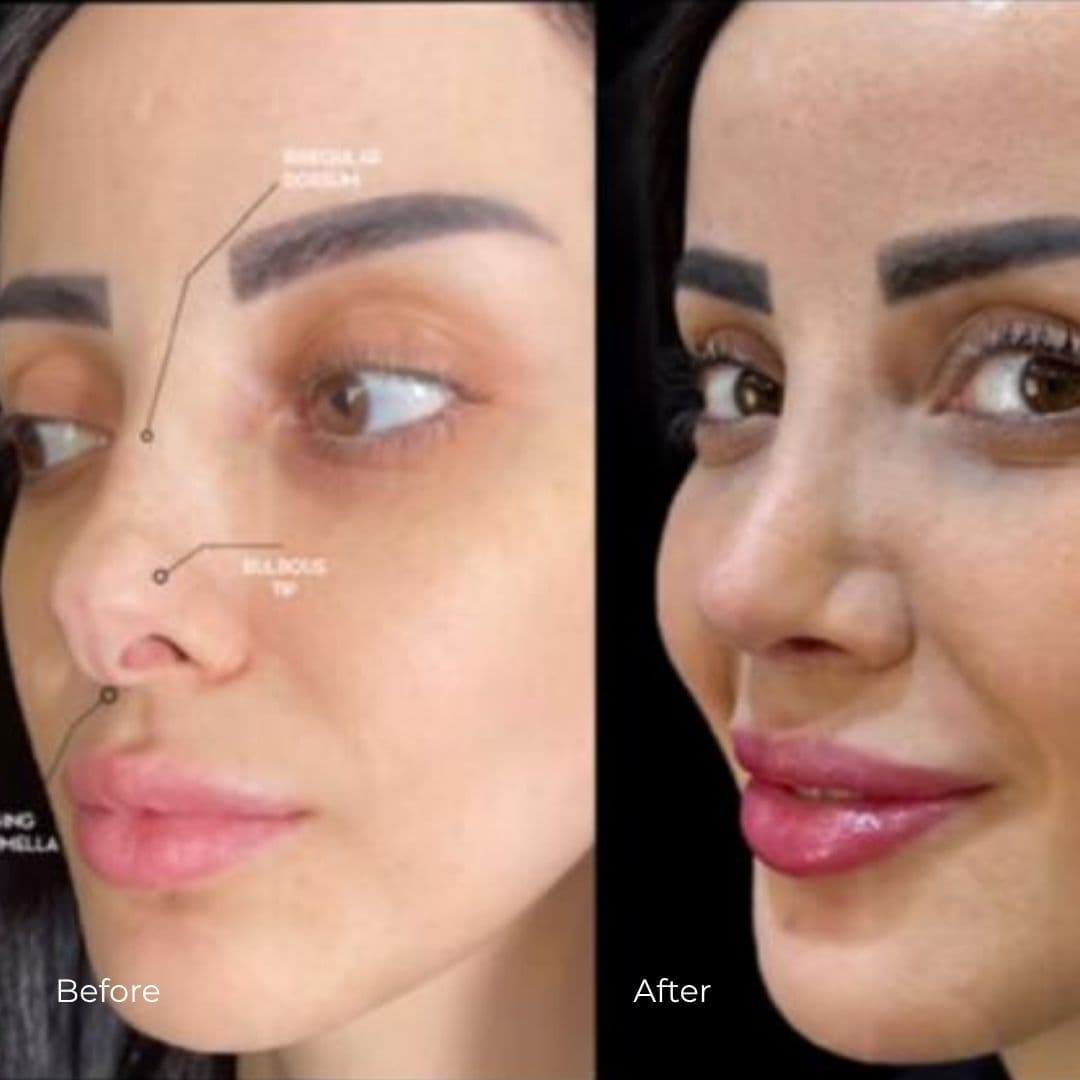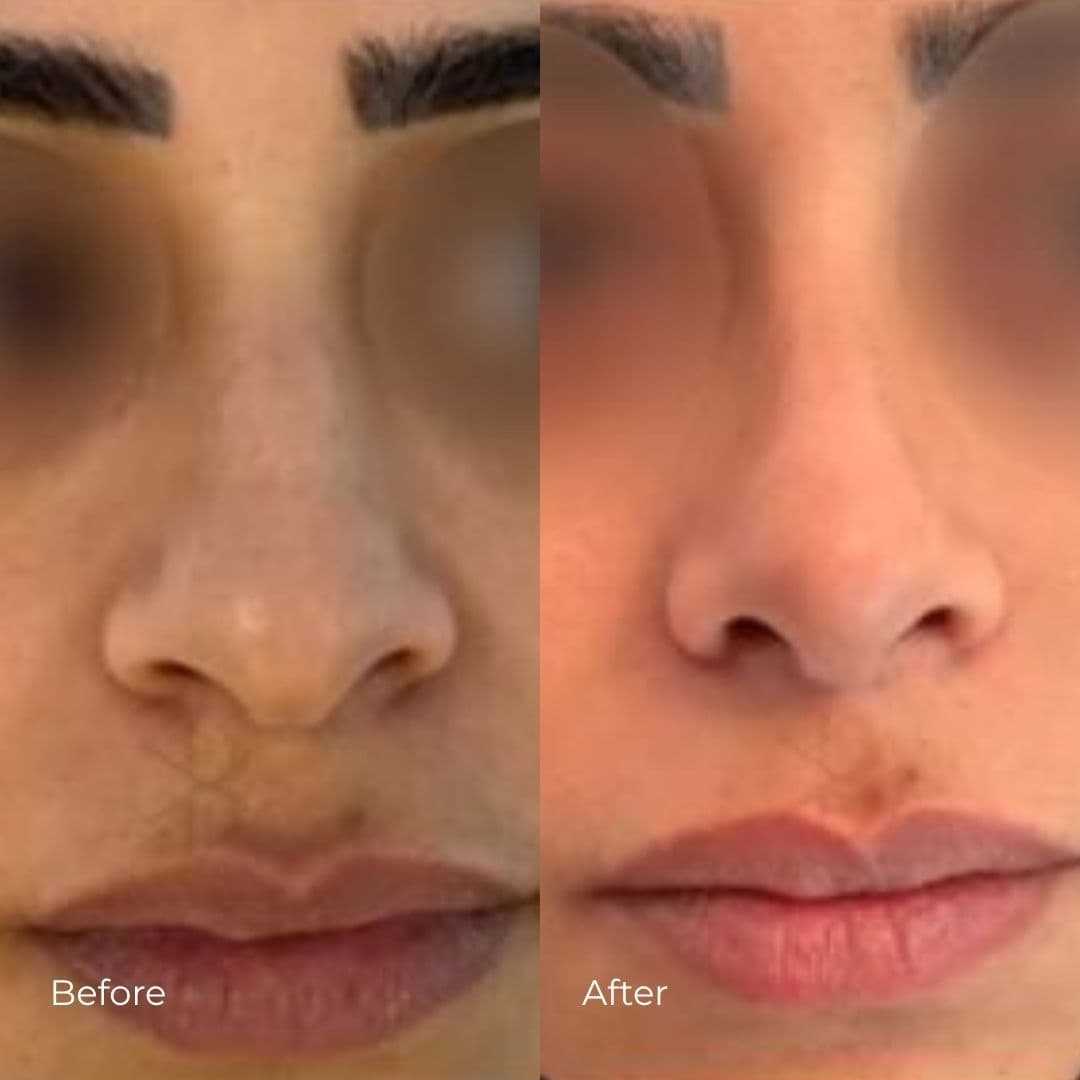Nose Reshaping (Rhinoplasty)

Facial Harmony Starts with the Nose job
A refined facial profile with graceful contours and a neat nose is a cherished dream and goal for many people today. This is often the case when the proportions of the face fall short of conventional standards.
The architectural center of the face is the nose, and it is this area that has the power to give the face classic, harmonious proportions — making it striking, beautiful, and elegant — or, conversely, unappealing, harsh, or heavy. Unfortunately, we do not choose our appearance, and not everyone is lucky in this regard.
The key is to remember that everyone has a different idea of what constitutes an ideal face. It’s very likely that the issue you see in the mirror goes unnoticed by anyone else. However, if you feel certain that this area of your face needs correction, modern aesthetic medicine offers excellent solutions.
Nose surgery can help address any imperfections of the nose. In addition to aesthetic concerns, nose reshaping also addresses medical issues, such as improving nasal breathing by correcting airway defects. At Seline Clinic, we offer nose operations using the latest techniques. Let’s dive into the details.
- Procedure Description
- Benefits of the Procedure
- How to Prepare for the Procedure?
- Who is a Good Candidate for the Procedure?
- Risks
- Contraindications
- Post-Treatment Care
- Stages
- Seline for You!
- Certificates and Licenses
- Dubai Location
- Discounts and Promotions
- Reviews
- Specialists Who Provide This Service
- Price List
- Happy to welcome you at Seline
- Questions And Answers
Procedure Description
Rhinoplasty is a surgical procedure designed to correct the shape and structure of the nose, with the goal of enhancing facial harmony while preserving the patient’s unique features.
Rhinoplasty can be performed for both aesthetic and medical reasons. Often, a preliminary examination reveals the need not only for aesthetic correction but also for addressing structural defects, such as deviated septum.
Aesthetic Indications include concerns with the nose's shape, size, proportions, or overall appearance. Common aesthetic concerns are:
- Broad nasal tip or a hooked nose;
- Irregular "saddle" shape;
- Nasal hump on the bridge of the nose;
- Deformities caused by trauma;
- An excessively long or wide nose;
- Large, asymmetrical nostrils.
Medical Indications for plastic surgery typically involve correcting a deviated septum, restoring proper nasal breathing, or addressing the effects of trauma or previous unsuccessful surgeries.
Nose shaping procedures can be classified as open or closed, with the surgical approach determined by the doctor by the patient's anatomy.
Open Rhinoplasty involves making incisions on the columella (the tissue between the nostrils), providing more access to the internal structures of the nose.
Closed Rhinoplasty is a technique where incisions are made inside the nostrils, leaving no visible external scars.
Additional Types of Rhinoplasty:
- Revision Rhinoplasty: A secondary surgery aimed at improving or correcting the results of a previous nose job;
- Functional Rhinoplasty: Focused on restoring nasal breathing and correcting structural issues that affect the nose’s functionality;
- Aesthetic Rhinoplasty: Primarily concerned with improving the appearance of the nose to enhance facial harmony.
Aesthetic rhinoplasty is further divided into specific nose jobs, including:
- Augmentation Rhinoplasty: nasal augmentation designed to enlarge the nose;
- Reduction Rhinoplasty: nose reduction;
- Nasal Tip Refinement;
- Reconstructive Rhinoplasty: performed to address complex deformities or pathologies;
- Ethnic Rhinoplasty: Correcting the shape of the nose reflecting characteristics of a specific ethnicity, often to achieve a more European appearance.
Benefits of the Procedure
Key Advantages of Rhinoplasty:
- Plastic surgery provides a highly effective outcome that lasts a lifetime;
- Nose reshaping can correct a wide range of imperfections, including severe structural changes caused by trauma;
- With various rhinoplasty techniques available, there is a solution for every unique concern;
- Nose operations are generally well-tolerated, with 99% of patients experiencing no complications during recovery.
How to Prepare for the Procedure?
As with any surgical procedure, rhinoplasty requires careful preparation. During your initial consultation, your surgeon will discuss your expectations and goals for the surgery. A thorough diagnosis will then be performed to identify any potential contraindications. This typically includes:
- Laboratory tests;
- Cardiogram;
- Fluorography (chest X-ray);
- X-ray of the sinuses.
Additionally, patients are advised to refrain from alcohol, smoking, and blood-thinning medications such as aspirin for at least two weeks prior to surgery to ensure optimal healing.
Who is a Good Candidate for the Procedure?
Nose surgery is suitable for anyone looking to improve the appearance of their nose via cosmetic rhinoplasty or correct functional issues for medical reasons. The procedure is commonly performed on both women and men, typically between the ages 18-20 and 70-75.
Risks
As with any surgical procedure, rhinoplasty carries certain risks. These are generally manageable and can include:
- Numbness in the area of the surgery;
- Temporary difficulty breathing through the nose or a loss of the sense of smell;
- In some cases, noticeable scarring or prolonged healing is possible, particularly for certain patients.
Contraindications
To minimize the risk of complications and ensure a smooth recovery, it's important to consider the contraindications for the procedure. Rhinoplasty should not be performed if you have:
- Hemophilia;
- Heart or vascular conditions;
- Central nervous system disorders;
- Decompensated diabetes mellitus;
- Malignant neoplasms;
- Mental abnormalities that affect communication or cooperation;
- Pregnancy or breastfeeding;
- Acute infectious diseases.
At Seline Clinic, our expert rhinoplasty surgeons are dedicated to achieving flawless results. We prioritize not only aesthetic improvements but also the preservation of nasal function and overall health. Our team is highly experienced, handling even the most complex cases with precision. With our doctors, no challenge is too great — they know rhinoplasty inside and out, from the basics to the most advanced techniques.
Post-Treatment Care
Once you are discharged from the hospital, typically on the 2nd or 3rd day, the recovery period begins. This phase can last anywhere from two weeks to two months, depending on the complexity of the procedure and the extent of the intervention. During this time, it’s essential to follow some simple guidelines to ensure a smooth recovery and maintain the positive results of your surgery.
Recommendations:
- Avoid alcohol and smoking;
- Steer clear of saunas and tanning beds to prevent the risk of bleeding;
- Avoid strenuous exercise and sports;
- Do not apply makeup on face;
- Sleep in a half-sitting position;
- Take all prescribed medications as instructed;
- Apply antiseptics to your sutures;
- Keep the dressing on.
Once your stitches are removed, your surgeon will assess your recovery progress and gradually lift any remaining restrictions.
Be patient — the results are worth it!
Stages
1.
Consultation;
2.
Preparation for surgery, examinations, tests;
3.
Anesthesia;
4.
Execution of incisions;
5.
Main procedure: augmentation or removal of hard and soft tissues, cartilage.
6.
Completion of the procedure, suturing;
7.
Antiseptic care, the wound is covered with a dressing to prevent infection;
8.
Hospital stay, check-ups;
9.
Discharge, receiving recommendations from the specialist;
10.
Rehabilitation;
11.
Evaluation.
In 99% of cases, rhinoplasty meets or exceeds the patient’s expectations, especially when performed by skilled professionals! The benefits include:
- A nose shape and size that harmonizes beautifully with your facial features;
- Nasal hump removal on the bridge of the nose;
- Lifting and refining the tip of the nose, nose reduction;
- Enhanced facial proportions for a more balanced appearance;
- No snoring;
- Improved nasal breathing functionality.
When rhinoplasty is performed with precision and aftercare guidelines are followed, the results are outstanding, bringing you positive changes that can last a lifetime.
Seline for You!
Rhinoplasty is the ideal solution to enhance your facial features and achieve a more harmonious, attractive appearance. At Seline Aesthetics Medicine Center, our dedicated specialists truly care about both your beauty and well-being. Whether you are looking to refine the aesthetics of your nose or need surgery for medical reasons, we promise exceptional results tailored to your unique needs. Our approach is simple: personalized care, attentive sensitivity, and uncompromising quality.
We take your privacy seriously and adhere to the highest standards of confidentiality. Your personal information is always protected. If desired, we can offer you a discreet, private entrance so that your visit remains entirely confidential — your privacy is respected, and your visit stays between you and us.
Certificates and Licenses
We hold all the necessary certifications and licenses to provide the services we offer to our valued patients. For your peace of mind, we are happy to provide any supporting documents upon request.
Dubai Location
Our aesthetics medicine center is nestled in Jumeirah Road, Umm Suqeim First, a well-connected area of Dubai, with excellent transportation access.
We’ve designed our location with your convenience in mind, making it easy to reach us quickly from anywhere in Dubai — so you can spend less time on the road and more time on what truly matters!
Discounts and Promotions
Stay up-to-date with the latest promotions and discounts by following our website and social media channels. Be sure to check for updates so you don't miss out on the best offers!
We are waiting for you at Seline for healthy and aesthetic noses — of all shapes and sizes!

Dr. Kotti | Rhinoplasty

Dr. Kotti | Rhinoplasty

Dr. Kotti | Rhinoplasty

Dr. Kotti | Rhinoplasty

Dr. Kotti | Rhinoplasty

Dr. Kotti | Rhinoplasty

Dr. Kotti | Rhinoplasty

Dr. Kotti | Rhinoplasty

Dr. Kotti | Rhinoplasty

Dr. Kotti | Rhinoplasty
Reviews
Myriam Kraria
I had a blepharoplasty, rhinoplasty, temporal lift and botox as well with Dr. Kotti and frankly I couldn’t have dreamed better. From beginning to end you are accompanied at every step. The doctor takes the time to answer each question, explains all procedures so you understand exactly what you're going to do and why. He’s really there to beautify you and do the best for you — unlike some who are just in it for the money. You have the number of his assistants Alice and Milla and they answer at any time — which is incredible! On the day of surgery, they welcome you with flowers and gifts, stay with you until the doctor arrives. After the procedure, the doctor’s team takes care of everything. I had no pain, and they managed this part perfectly. The post-op follow-up is amazing: you see the doctor almost every week and stay in contact with him and the team. Honestly, I didn’t even know this level of care was possible. Thank you to the whole team for this incredible work. The result: I am rejuvenated with a natural result beyond my expectations. Thank you again a thousand times!
Doctors / Dr. Bouraoui Kotti
Services / Blepharoplasty, Nose Reshaping (Rhinoplasty), Skin Tightening and Lifting , Botox Treatment
amira rezgui
I had nose surgery with Dr.Bouraoui KOTTI and my experience was excellent. He is professional, precise, and the results look natural, elegant, and beautiful. Truly grateful and I highly recommend him.”thank you DR Bouraoui kotti
Doctors / Dr. Bouraoui Kotti
Services / Nose Reshaping (Rhinoplasty)
Specialists Who Provide This Service
Price List
| Service | Price, AED (from) | |
|---|---|---|
| Rhinoplasty | 30000 | |
| Rhino-tip plasty | 25000 |
Happy to welcome you at Seline



